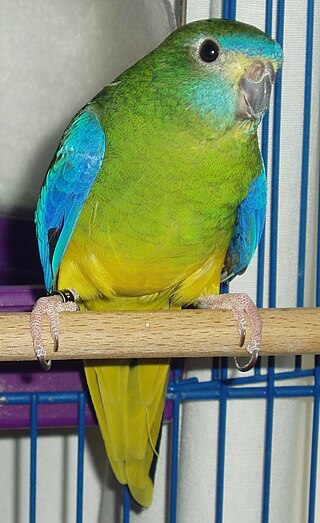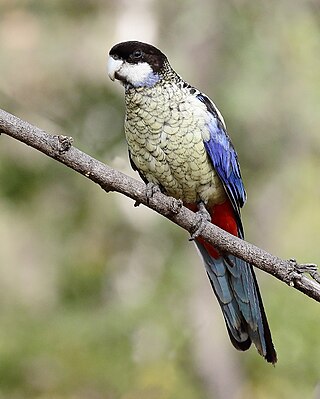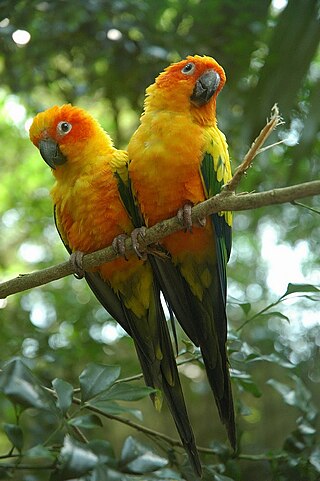
Platycercinae is a subfamily of birds belonging to the family Psittaculidae that inhabit Oceania. It consists of two tribes, the ground parrots and allies (Pezoporini) and the many species of broad-tailed parrot (Platycercini).

Members of the parrot genus Psittacula or Afro-Asian ring-necked parrots, as they are commonly known in aviculture, originate from Africa to South-East Asia. It is a widespread group with a clear concentration of species in south Asia, but also with representatives in Africa and the islands of the Indian Ocean. This is the only genus of parrot which has the majority of its species in continental Asia. Of all the extant species only Psittacula calthropae, Psittacula caniceps and Psittacula echo do not have a representative subspecies in any part of mainland continental Asia. The rose-ringed parakeet, Psittacula krameri, is one of the most widely distributed of all parrots.

The orange-bellied parrot is a small parrot endemic to southern Australia, and one of only three species of parrot that migrate. It was described by John Latham in 1790. A small parrot around 20 cm (8 in) long, it exhibits sexual dimorphism. The adult male is distinguished by its bright grass-green upper parts, yellow underparts and orange belly patch. The adult female and juvenile are duller green in colour. All birds have a prominent two-toned blue frontal band and blue outer wing feathers.

The eastern bluebonnet, also known as the greater bluebonnet, is an Australian parrot, one of two species in the genus Northiella. It was originally included in the genus Psephotus but due to distinctive physical and behavioural differences was reclassified into its own genus in 1994 by ornithologists and taxonomists Christidis and Boles. The bluebonnet is a medium-sized inland parrot commonly found in the interior of southeastern and central-southern Australia. It is adapted to life in semi-arid regions but can also flourish in regions of medium rainfall towards the eastern and southern extremities of its range.

Bourke's parrot, also known as the blue-vented parrot, sundown parrot, pink-bellied parrot, Bourke's parakeet, Bourke or "Bourkie", is a small parrot found in Australia and the only species in its genus, Neopsephotus. It is approximately 19 cm long and weighs around 45 grams. It is named after General Sir Richard Bourke, Governor of New South Wales from 1831 to 1837.

The genus Neophema is an Australian genus with six or seven species. They are small, dull green parrots differentiated by patches of other colours, and are commonly known as grass parrots. The genus has some sexual dichromatism, with males having brighter hues.

Rosellas are in a genus that consists of six species and nineteen subspecies. These colourful parrots from Australia are in the genus Platycercus. Platycercus means "broad-tailed" or "flat-tailed", reflecting a feature common to the rosellas and other members of the broad-tailed parrot tribe. Their diet is mainly seeds and fruit.

The colourful princess parrot is an Australian bird of the parrot family. Its name was given in honour of Princess Alexandra of Denmark, who in 1863 married the Prince of Wales Edward VII and eventually became Queen of the United Kingdom. Other names for the species include: Queen Alexandra parrot, Alexandra's parakeet, Princess of Wales parakeet, rose-throated parakeet, and spinifex parrot. Their plumage is mostly green with a pink throat, bluish crown and rump, and bright green shoulders.

The red-capped parrot is a species of broad-tailed parrot native to southwestern Australia. It was described by Heinrich Kuhl in 1820, with no subspecies recognised. It has long been classified in its own genus owing to its distinctive elongated beak, though genetic analysis shows that it lies within the lineage of the Psephotellus parrots and that its closest relative is the mulga parrot. Not easily confused with other parrot species, it has a bright crimson crown, green-yellow cheeks, and a distinctive long bill. The wings, back, and long tail are dark green, and the underparts are purple-blue. The adult female is very similar though sometimes slightly duller than the male; her key distinguishing feature is a white stripe on the wing under-surface. Juveniles are predominantly green.

The scarlet-chested parrot, known alternately as scarlet-breasted parrot, orange-throated parrot or splendid parrot, is a parrot endemic to central South Australia and inland southern Western Australia. The species is sexually dimorphic; the male has a bright blue face and scarlet chest and yellow underparts, amid overall green plumage, while the female is similar but lacks the red chest. These nomadic parakeets move readily from the Great Victoria Desert region into neighbouring areas. These interruptions are triggered by a search for more favourable conditions. They can survive quite well without access to drinking water, however, as succulent plants help meet much of their fluid requirement. They feed mainly on grass seeds and are most commonly sighted in spinifex.

The tribe Pezoporini is the sister clade of the tribe Platycercini that contains the broad-tailed parrots.

The ground parrot of Australia is one of only four ground-dwelling parrots in the world, the others being its closest relatives, the extremely rare night parrot, the somewhat closely related Antipodes parakeet, and the unrelated highly endangered kakapo from New Zealand.

The Moluccan king parrot is a parrot endemic to Peleng Island, Maluku, and West Papua in Indonesia. It is sometimes referred to as the Ambon king parrot or Amboina king parrot, but this is potentially misleading, as it is found on numerous other islands than Ambon. The male and female are similar in appearance, with a predominantly red head and underparts, green wings, and blue back and tail. Six subspecies are recognised, but only a few of these are regular in aviculture. In the wild, it inhabits rainforests and feeds on fruits, berries, seeds and buds.

The turquoise parrot is a species of parrot in the genus Neophema native to Eastern Australia, from southeastern Queensland, through New South Wales and into North-Eastern Victoria. It was described by George Shaw in 1792. A small lightly built parrot at around 20 cm (7.9 in) long and 40 g in weight, it exhibits sexual dimorphism. The male is predominantly green with more yellowish underparts and a bright turquoise blue face. Its wings are predominantly blue with red shoulders. The female is generally duller and paler, with a pale green breast and yellow belly, and lacks the red wing patch.

The rock parrot is a species of grass parrot native to Australia. Described by John Gould in 1841, it is a small parrot 22 to 24 cm long and weighing 50–60 g with predominantly olive-brown upperparts and more yellowish underparts. Its head is olive with light blue forecheeks and lores, and a dark blue frontal band line across the crown with lighter blue above and below. The sexes are similar in appearance, although the female tends to have a duller frontal band and less blue on the face. Two subspecies are recognised.

The green rosella or Tasmanian rosella is a species of parrot native to Tasmania and Bass Strait islands. It was described by the German naturalist Johann Friedrich Gmelin in 1788, and named on the mistaken assumption it came from New Caledonia. At 14.5 in (37 cm) long it is the largest species of the rosella genus, Platycercus. Two subspecies are recognised. The green rosella's underparts, neck and head are yellow, with a red band above the beak and violet-blue cheeks. The back is mostly black and green, and its long tail blue and green. The sexes have similar plumage, except the female has duller yellow plumage and more prominent red markings, as well as a smaller beak. Juvenile and immature birds have predominantly green plumage.

The northern rosella, formerly known as Brown's rosella or the smutty rosella, is a species of parrot native to northern Australia, ranging from the Gulf of Carpentaria and Arnhem Land to the Kimberley. It was described by Heinrich Kuhl in 1820, and two subspecies are recognised. The species is unusually coloured for a rosella, with a dark head and neck with pale cheeks—predominantly white in the subspecies from the Northern Territory and blue in the Western Australian subspecies hillii. The northern rosella's mantle and scapulars are black with fine yellow scallops, while its back, rump and underparts are pale yellow with fine black scallops. The long tail is blue-green, and the wings are black and blue-violet. The sexes have similar plumage, while females and younger birds are generally duller with occasional spots of red.

The golden-winged parakeet is a species of bird in subfamily Arinae of the family Psittacidae, the African and New World parrots. It is found in Bolivia, Brazil, French Guiana, Guyana, Suriname, and Venezuela.

The elegant parrot is a species of parrot in the family Psittaculidae. It is endemic to Australia.

The sun conure, also known as the sun parakeet, is a medium-sized, vibrantly colored parrot native to northeastern South America. The adult male and female are similar in appearance, with black beaks, predominantly golden-yellow plumage, orange-flushed underparts and face, and green and blue-tipped wings and tails. Sun conures are very social birds, typically living in flocks. They form monogamous pairs for reproduction, and nest in palm cavities in the tropics. Sun conures mainly feed on fruits, flowers, berries, blossoms, seeds, nuts, and insects. Conures are commonly bred and kept in aviculture and may live up to 30 years. This species is currently threatened by loss of habitat and trapping for plumage or the pet trade. Sun conures are now listed as endangered by the International Union for Conservation of Nature.





















